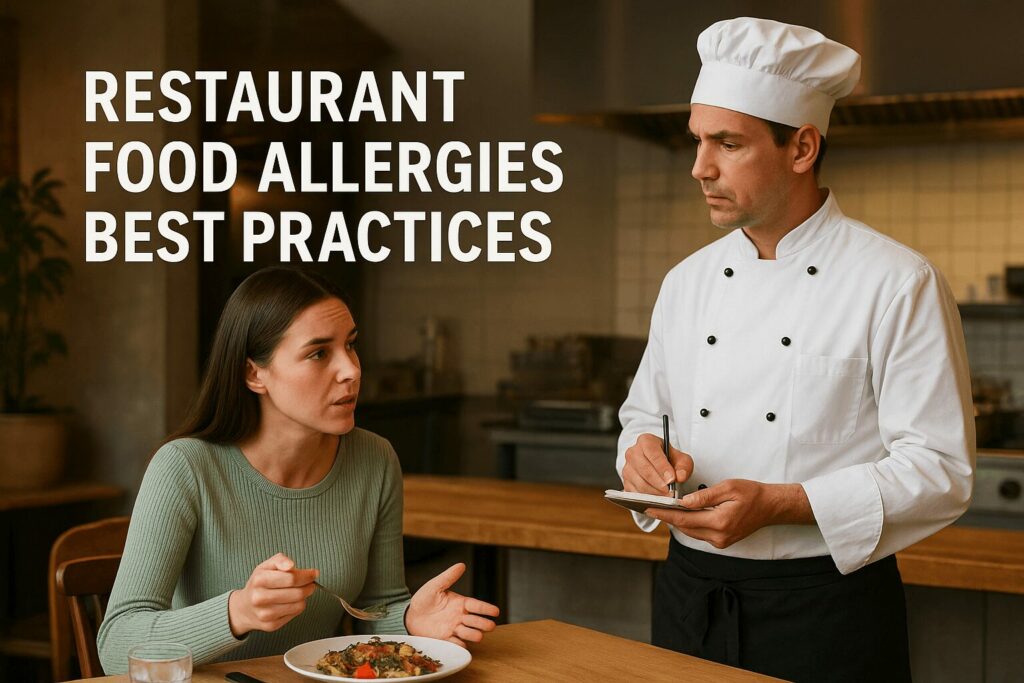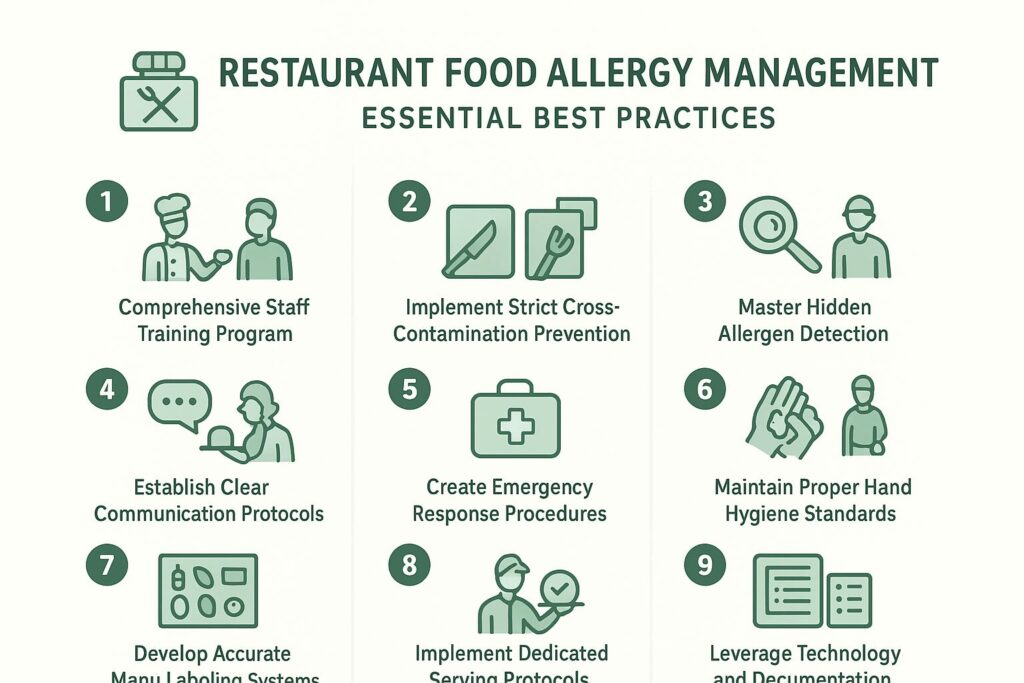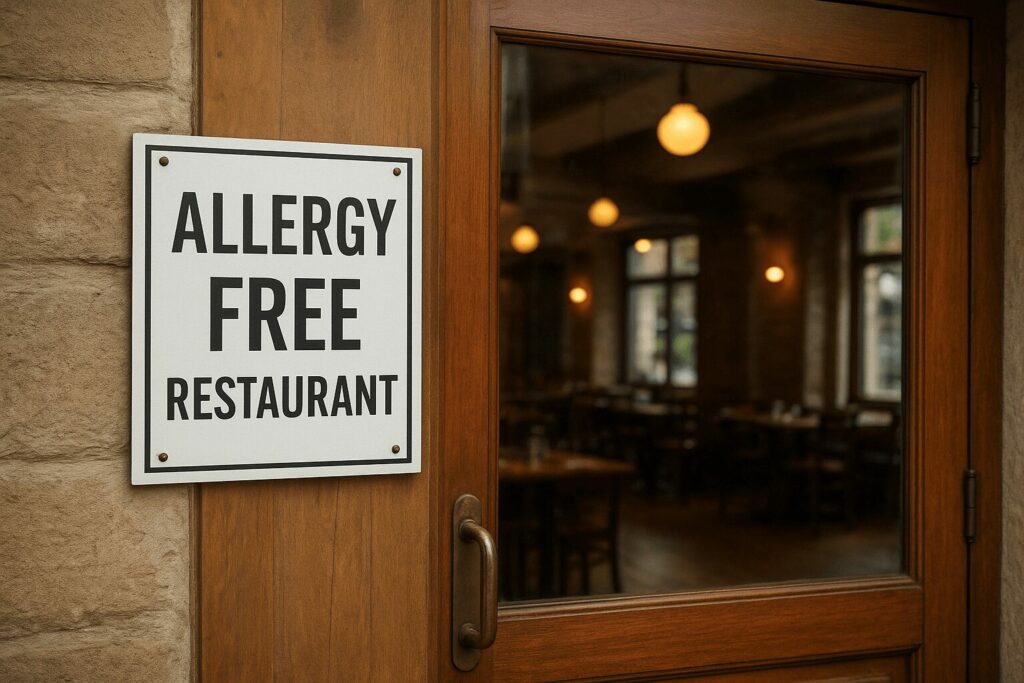
Food allergy safety guide for restaurants 🍽️
Alright, let’s talk food allergies restaurant nightmares—imagine a customer’s dream meal turning into a life-or-death situation. 😳 With, for example, 33 million Americans at risk, slipping up on allergens isn’t just a PR crisis—it’s a business killer. Think peanut traces in a “nut-free” dish or gluten hiding in soy sauce—tiny mistakes with huge consequences. This article breaks down how to dodge cross-contamination landmines, decode sneaky allergens, and turn safety into your secret weapon for customer loyalty. Spoiler: We’re serving up actionable checklists, kitchen-safe zones, and why training your team to be “allergy detectives” could save your restaurant’s rep (and their lives). Ready to flip the script? 🚀
Article Takeaways
Food Allergies Restaurant Management: Essential Best Practices
Managing food allergies effectively is critical for restaurant success, with 33 million Americans at risk and 86% of allergy sufferers choosing restaurants based on allergen policies. Here are the essential best practices every restaurateur must implement:
1. Comprehensive Staff Training Program
Train all team members—from chefs to dishwashers—on the 14 major allergens (milk, eggs, fish, crustaceans, tree nuts, peanuts, wheat, soybeans, mustard, lupin, sesame, celery, mollusks, and sulfites). Make training a regular refresher course, not a one-time event, and ensure staff can recognize allergic reaction symptoms.
2. Implement Strict Cross-Contamination Prevention
Create dedicated allergen-free preparation zones with color-coded cutting boards and utensils. Establish a protocol where allergen-free dishes are prepared first, using fresh gloves and clean surfaces for each order. Store allergen-free ingredients on top shelves to prevent contamination from above.
3. Master Hidden Allergen Detection
Train staff to identify sneaky allergens like anchovies in Worcestershire sauce, wheat in soy sauce, and sesame in salad dressings. Require thorough ingredient screening for all dishes, treating allergen management like airport security—no assumptions, full verification.
4. Establish Clear Communication Protocols
Implement a system where servers repeat allergen information back to customers for confirmation, use allergy alert stickers on orders, and ensure direct communication between front-of-house and kitchen staff. Never rely on verbal notes alone—use written documentation for all allergy orders.
5. Create Emergency Response Procedures
Develop a clear emergency protocol including immediate 911 calls, never leaving an allergic customer alone, and knowing how to assist with EpiPen usage without administering it yourself. Post emergency procedures visibly in the kitchen and train all staff on these life-saving steps.
6. Maintain Proper Hand Hygiene Standards
Enforce soap and water hand washing over hand sanitizer, as alcohol doesn’t eliminate allergen proteins. Require fresh gloves for each allergen-free dish preparation and establish strict hand-washing protocols between handling different ingredients.
7. Develop Accurate Menu Labeling Systems
Create transparent menu labeling with clear allergen information and maintain up-to-date ingredient lists. Use digital menus with allergen filters when possible and ensure all staff can access current ingredient information for customer inquiries.
8. Implement Dedicated Serving Protocols
Cover allergen-free dishes immediately after plating, have managers or chefs personally deliver these orders, and confirm no cross-contact occurred before serving. Never allow untrained staff to deliver allergy-sensitive orders without proper briefing.
9. Leverage Technology and Documentation
Consider implementing HACCP (Hazard Analysis Critical Control Points) systems to track allergen risks at every preparation step. Use technology solutions like allergen management apps and maintain detailed records of protocols and staff training.
The Business Impact: Restaurants that excel at allergy management see 86% customer retention rates among allergy sufferers, with these customers showing higher loyalty and less price sensitivity than average diners. Effective allergy protocols transform safety compliance into a competitive advantage and revenue driver.

Table of Content
- Why your restaurant needs a food allergy game plan, like, yesterday 😮
- Getting to know the main culprits: the top food allergens
- The kitchen minefield: where things can go wrong 💣
- Your action plan: building an allergy-safe restaurant
- Beyond the basics: from compliance to competitive advantage 🏆
- Let’s make dining out safe and fun for everyone 🎉
Why your restaurant needs a food allergy game plan, like, yesterday 😮
Alright, food allergies – that “not a big deal” thing? Spoiler: it is. For example, over 33 million Americans have allergies – 1 in 10 people. Imagine 10 customers: one could be risking their life. Still ignoring this? 86% of allergy sufferers stick to trusted restaurants. Lose them? You’re losing repeat business. Ouch.
Food allergies restaurants is a bigger deal than you think
Allergies aren’t just kid stuff. 51% of reactions are severe, and 80% of sufferers pick restaurants based on allergen policies. Ignore this? You’re turning away cash. 44% of non-allergy customers care too. Pro tip: 45% of allergy sufferers have multiple allergies. Nail one safe menu = happy, loyal customers.
More than just a tummy ache
Allergies can kill. Anaphylaxis needs epinephrine now. Delays = death. Cross-contamination isn’t kitchen jargon – it’s a silent killer. One crumb = game over. Staff knowledge? The line between a happy customer and an ambulance. 38% of sufferers have visited ERs for reactions. Scary and expensive.
The silver lining: turning safety into success
Here’s the twist: allergy safety isn’t just compliance – it’s a goldmine. 30% of sufferers are fiercely loyal to places that get it right. They’ll bring friends, write 5-star reviews, and become your brand squad. Bonus: these customers are less price-sensitive – only 39% cite cost as a barrier vs. 65% of others. Nail this, and integrate it into your sustainable hospitality marketing strategies – you’re turning a challenge into opportunity! 💡
Getting to know the main culprits: the top food allergens
The « big 9 » in the US
🚨 The FASTER Act mandates 9 major allergens all US restaurants must track. These include milk, eggs, wheat, soy, fish, crustaceans, peanuts, tree nuts, and sesame (added in 2023). This « danger zone » list triggers legal labeling requirements. Why sesame? It’s everywhere—from tahini to burger buns to Asian dressings. Post-2023, even trace amounts must be declared!
Watch « CONTAINS » warnings on ingredient lists—they’re your first defense. Be cautious: sesame now appears in unexpected places like sauces and oils post-FASTER Act. Always double-check fresh packaging—formulas change! Pro tip: Cross-contamination risks are real. A knife used for peanut butter then jelly? Instant allergen nightmare. 🔥
A closer look at the 14 common allergens
Expand your radar to 14 allergens (including EU-specific ones). These hide in broths, sauces, and seasonings—mastering this list keeps customers safe. 🌍 For example, celery isn’t just a garnish—it’s in spice blends and soups. Sulphites? They’re preservatives in wines and dried fruits that can trigger reactions.
- 🥛 Milk: Present in dairy products and sauces like béchamel
- 🥚 Eggs: Common in meatballs, mayonnaise, and batters
- 🥜 Peanuts: Found in Asian sauces (like satay) and desserts
- 🌰 Tree nuts: Almonds, walnuts, and pesto ingredients
- 🐟 Fish: Anchovies in dressings are sneaky culprits
- 🦐 Crustaceans: Shrimp, crab, and lobster in stocks
- 🌾 Wheat: In bread, pasta, soy sauce, and gravies
- 🌱 Soy: Tofu, edamame, and processed foods
- 芝麻 Sesame: New 2023 addition in sauces, oils, and buns
- 🌿 Celery: Stocks, soups, and spice blends
- 🌶️ Mustard: Seeds/powder in dressings and marinades
- 🌸 Lupin: Gluten-free flour ingredient (common in European baked goods)
- 🐌 Molluscs: Shellfish like mussels and clams
- 💨 Sulphites: Preservatives in dried fruits and wine
Pro tip: Tingling mouth = allergen alert! Even traces matter. Cross-contact happens easily—use separate utensils for allergen-free meals. Check out UK Food Standards Agency guidelines for labeling hacks!
The kitchen minefield: where things can go wrong 💣
The invisible enemy: cross-contamination
Think of cross-contact as a microscopic saboteur. A single speck of peanut dust from a cutting board can ruin a « peanut-free » dish. A spatula used for shellfish pasta, then waved over your salad? Disaster. Even shared fryer oil acts like a allergen taxi service for unsuspecting diners.
Here’s the scary part: researches shows 53.9% of U.S. restaurant allergy reactions happen despite clear customer warnings. Why? Because that tiny allergen trace still sneaks through – think of it as the kitchen’s version of Murphy’s Law. A chef wiping a surface with a « clean » cloth leaves invisible protein traces. A server’s « I’ll just wipe this plate » gesture becomes a biohazard. Even shared seasoning shakers spread danger.
Hidden allergens and misinformed menus
Worcestershire sauce isn’t just « weird tasting » – it hides anchovies (fish allergy danger zone!). That « safe » tomato soup might contain wheat-based thickener. Ever consider that your soy sauce could secretly harbor wheat? This isn’t culinary trickery – it’s why every ingredient needs detective-level investigation.
Menus claiming « peanut-free » might still serve dishes cooked in oil that just finished frying tempura. Your « gluten-free » pasta could be contaminated by shared preparation surfaces. Think of allergen management like airport security – no assumptions, full ingredient screening. Ever heard of sesame sneaking into salad dressings? Or crustaceans hiding in fish stock? Even « vegan » dishes risk cross-contamination near seafood. The CDC warns 8.8% of restaurant allergy incidents stem from these hidden sources.
The communication breakdown
Picture this: Customer tells server about shellfish allergy → server nods → chef forgets to check broth ingredients → disaster. That’s the restaurant version of telephone game gone wrong. Servers might « interpret » warnings as « just a mild sensitivity ». Kitchen staff might shrug off allergy notes during rush hour.
It’s not about malice – it’s about systems failure. When no one owns the allergy process, mistakes multiply. Imagine handling allergy info like a hot pan – passing it quickly without proper grip. Food.gov.uk highlights how handwritten notes getting lost causes 41% of preventable incidents. Color-coded prep areas reduce risks by 60% – a simple fix for a complex problem.

Your action plan: building an allergy-safe restaurant
Train your team to be allergy detectives
Alright, let’s start with your secret weapon: your staff. 🕵️♂️ Every team member needs to know their allergen ABCs. Think of this as your restaurant’s superhero training program.
Here’s the deal:
- Everyone gets trained – from chefs to dishwashers. No exceptions!
- Focus on the 14 heavy hitters: milk, eggs, fish, crustaceans, tree nuts, peanuts, wheat, soybeans, mustard, lupin, sesame, celery, mollusks, and sulfites.
- Teach them to spot symptoms (itchy rashes? Trouble breathing? That’s emergency time!)
- Massachusetts’s FAAA law proves this works – maybe it’s time to follow suit?
Pro tip: Make training a refresher course, not a one-time event. Knowledge fades faster than a forgotten sauce on the stove!
Create food allergies restaurant safe zones: preventing cross-contamination
Think of your kitchen like a chemistry lab – one wrong mix and BOOM! 💣 Here’s how to keep things clean:
- Color-coded tools: Red cutting boards for gluten-free, blue for seafood-free – make it visual!
- Hand hygiene: Soap + water beats hand sanitizer every time. Alcohol doesn’t kill allergen proteins!
- Prep area protocol: Use fresh gloves + clean surfaces. Imagine you’re prepping goldfish – you wouldn’t use the same tools for peanut butter!
- Storage secrets: Put allergen-free items on top shelves. Trust us, spaghetti rain isn’t cute when it’s gluten-free pasta.
Bonus tip: Prep allergy-friendly dishes first. It’s like VIP treatment for your food-sensitive guests!
Your front-of-house playbook
| Situation | ✅ DO | ❌ DON’T |
|---|---|---|
| A customer mentions an allergy | Repeat the allergy back to confirm. Alert kitchen immediately. Use allergy alert stickers on orders. | Assume « trace amounts » are safe. Ever seen a chef measure a life-threatening reaction with a teaspoon? Nope. |
| Allergy order in kitchen | Use dedicated utensils. Prep in separate area. Label clearly. | Double-dip utensils. That shared fryer? It’s basically an allergen soup. |
| Plating allergy-safe dish | Cover it immediately. Deliver via manager/chef. Extra clean serving area. | Garnish last-minute. You wouldn’t add glitter to a wedding cake, right? |
| Serving the dish | Explain ingredients. Confirm no cross-contact occurred. | Let another server deliver without allergy warning. It’s like handing someone a ticking time bomb. |
Front-of-house crew – you’re the communication superheroes! 💬
- Ask allergy questions at every table. Make it part of your standard script.
- Train staff to read ingredient labels like they’re deciphering ancient hieroglyphs.
- Use digital menus with allergen filters. Tech is your friend here!
What to do when a reaction happens
Let’s hope this never happens, but better safe than sorry. 🚨 Here’s your emergency checklist:
- Never leave the person alone. Panic is contagious!
- Call ambulance immediately. No waiting for « maybe it’ll pass. »
- Ask if they have an EpiPen. Help them use it if needed, but don’t administer it yourself.
Pro tip: Keep a printed copy of the UK Food Standards Agency’s emergency protocol in your staff manual. Better yet – tape it on the kitchen wall!
Beyond the basics: from compliance to competitive advantage 🏆
The rules of the game (are a bit confusing)
Alright, let’s talk legal realities. Federal laws like FALCPA and the FASTER Act? They don’t apply to restaurant-prepared meals. Crazy, right? That means your compliance roadmap depends on a patchwork of state/local regulations. Yep, like Illinois requiring allergy training or Massachusetts mandating menu warnings – it’s a delicate balancing act.
Inconsistent regulations create real headaches. The takeaway? Don’t wait for legal pressure to act. Proactive restaurants already understand: building trust with allergy-conscious diners boosts loyalty (92% return rate!) and unlocks serious revenue potential.
How to market your allergy-friendliness
Think your allergy-friendly efforts deserve applause? Absolutely, mate! Here’s how to turn them into marketing gold:
- Dedicate a section on your website: Showcase your protocols, staff training, and someone customers can contact. Transparency builds trust!
- Shout it out on social media: Feature those gluten-free creations! Positive guest experiences = free advertising.
- Empower your staff: Confident servers = customer confidence. Train them to handle questions like pros.
- Update your online menus: Clear labels/icons for major allergens make customers feel safe. Bonus points for mobile-friendly menus!
- Partner with allergy bloggers: Local influencers can turn your place into a « must-visit » in the allergy community.
Pro tip: 86% of allergy customers base loyalty on restaurant responses. Make them feel seen – they’ll bring friends, family, and rave reviews!
Advanced tools for the pros: HACCP and beyond
Ready to become an allergy-safety leader? Think of HACCP as your restaurant’s GPS for allergen control. This system helps you map exactly where allergens might sneak into dishes – then puts roadblocks in place.
Imagine tracking contamination risks at every step – from ingredient storage to final plating. While it sounds technical, HACCP boils down to smart risk management. The payoff? Reduced liability, better customer confidence, and a reputation as a trailblazer. Bonus: 44% of non-allergic customers care about allergy protocols too – so you’re tapping into a wider market!
Remember: The average restaurant misses 30% of potential allergen risks. HACCP helps you close those gaps in terms of food allergies restaurant. Not just compliance – this is your ticket to customer loyalty gold.

Let’s make dining out safe and fun for everyone 🎉
Managing food allergies creates a space where everyone feels safe. Restaurants that prioritize allergy safety build loyalty – 80% of allergic customers choose venues based on allergy policies. Let’s make this happen!
A final word for the restaurant team
Allergy management isn’t a trend – it’s premium customer service. Train staff using programs like Food Allergy Canada’s resources, covering the 14 major allergens. Clear communication saves lives: top chefs at Michelin-starred restaurants use checklists and double-check protocols. Top chefs agree: prevent cross-contamination with dedicated prep zones and tools. This builds trust – 36% of allergic customers become super-loyal when done right, spending the same as non-allergic diners.
Tips for diners: how to be your own best advocate
- Do your homework: Check menus online first. Call during quiet hours.
- Be specific: Say “I have a life-threatening allergy to peanuts and tree nuts” – not just “nuts”.
- Ask kitchen-level questions: “How do you prevent cross-contact?”
- Carry meds: Keep epinephrine accessible – 1 in 3 restaurant emergencies involve allergies.
- If unsure, skip it: Better safe than sorry. Your caution helps others.
When both sides team up, magic happens. Clear communication turns risks into trust-building moments. 86% of allergic customers become loyal regulars when they find a safe spot – let’s make your place that space where safety meets deliciousness 🍽️!
Alright, let’s wrap this up! 🤝 Managing allergies isn’t just avoiding disasters—it’s building trust and loyalty that 5-star reviews can’t match. 🌟 Nail it, and you’re serving confidence, not just meals. Train your crew, turn your allergy plan into a secret weapon. A safe table = a full table. Guests reward you with loyalty trends can’t touch. 🍽️✨
Q / A About Food Allergies Restaurant
Can a Restaurant Be Held Responsible for Allergic Reactions?
Absolutely, mate! Restaurants can indeed face legal heat for allergic mishaps. While federal laws like FALCPA don’t force them to label allergens, they’re still on the hook for keeping customers safe. Think of it as a « trust contract » – if they mess up, clients could sue for medical bills, pain, or worse. Quick fix? Train your team religiously, document everything, and have clear protocols. The Massachusetts law? Total game-changer – their FAAA rules made training mandatory, and guess what? Your customers will thank you for it.
What Are the Top 9 Allergens Most Commonly Found in Restaurants?
Alright, let’s talk numbers! The “Big 9” food allergies in the US are milk, eggs, peanuts, tree nuts, fish, shellfish, wheat, soy, and sesame (added in 2023). These guys cause 90% of reactions. But hey, don’t sleep on the “extra 5” either – like lupin (found in gluten-free flours) or sulphites in wines. For real, cross-contamination is the sneaky villain here – imagine a crumb of peanut butter ruining a “nut-free” dish. Yep, 54% of restaurant reactions happen after a guest warns them. Ouch.
What Legal Responsibilities Do Restaurants Have for Food Allergies?
Short answer? Big ones. Restaurants don’t have to follow FALCPA’s labeling rules, but they’re still liable if they drop the ball. Think of it as running a tight ship: ✅ Train staff like it’s the law (because it is in MA). ✅ Create “allergy-free zones” with color-coded tools. ✅ Lock down communication – if a guest says “I’m allergic,” that info needs to scream across the kitchen. Skip this? You’re looking at fines, lawsuits, or even criminal charges. Not worth the splurge, trust us.
Is Chick-fil-A Safe for People with Nut Allergies?
Hard pass? Not exactly. Chick-fil-A’s website shouts “no peanuts, tree nuts, or coconut” but here’s the kicker: their fry oil is refined peanut oil (which is allergen-free by USDA standards). Still, cross-contamination’s a risk – their nuggets share fryers with other items. Want to play it safe? Ask them to change gloves, use fresh utensils, and avoid sauces (some have hidden tree nut oils). Better safe than sorry!
What Are the Legal Consequences for Restaurants if Someone Has a Severe Allergic Reaction?
Here’s the deal: compensation depends on how bad things go. If someone ends up in the ER? Think $ thousands in medical bills. If they die? We’re talking millions (like the $4.3M awarded in a 2018 seafood case). But even minor slip-ups? Restaurants still lose – 31% of allergic customers stop visiting, taking their $400B allergy-friendly market with them. Ouch. Pro tip? Prevention’s cheaper than payouts.
What Should Restaurant Staff Do During a Customer’s Allergic Emergency?
First rule: Don’t panic. Second rule: Call ambulance immediately. Third? Ask if they’ve got an EpiPen and help them use it if needed. But here’s the catch – staff shouldn’t touch the injection themselves; that’s a legal minefield. Quick action = life-saver. Pro tip? Have an emergency checklist posted – even a “call 911” sticker near the POS. Better yet, train everyone to spot reactions early – it’s worth the splurge.
What’s the Most Common Food Allergy Worldwide?
Drumroll… Seafood allergies! Fish and shellfish top the global charts, affecting 2.8% of adults. But in the US? Peanuts and tree nuts are the real menace – responsible for 28% of restaurant reactions and 3 in 10 epinephrine uses. And guess what? 1 in 10 adults has adult-onset allergies – so your “safe” menu item might not stay safe forever. Stay sharp!
How Should Kitchen Staff Handle a Customer Having an Allergic Reaction?
Stop everything. Prioritize their order like it’s VIP. Use dedicated utensils, fresh gloves, and prep their food after others. Got a nut allergy? Change your cutting board – seriously. And don’t just shout “nut allergy” across the kitchen; put it on the ticket in bold. Oh, and have a manager double-check the dish before it leaves the pass. Quick, clean, paranoid – that’s the vibe.
What’s a Lupin Allergy and Why Is It Mentioned in Food Allergies Restaurant Highlights?
Lupin’s the underdog allergen – a legume in gluten-free flours and pastries. It’s a sneaky one too; 1 in 5 wheat-allergic folks react to it. The EU’s been on this since 2014, but the US? Still playing catch-up. For restaurants: check your “gluten-free” menu items – that flour might hide lupin. Label it or lose customers. Simple as that.
